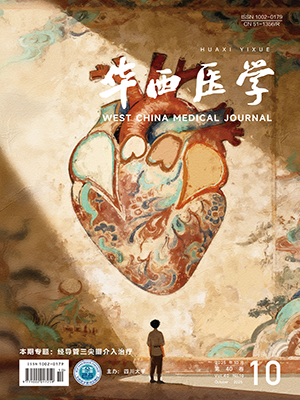| 1. |
Wu SM, Wu B, Liu M, et al. Stroke in China: advances and challenges in epidemiology, prevention, and management. Lancet Neurol, 2019, 18(4): 394-405.
|
| 2. |
GBD 2016 Lifetime Risk of Stroke Collaborators, Feigin VL, Nguyen G, et al. Global, regional, and country-specific lifetime risks of stroke, 1990 and 2016. N Engl J Med, 2018, 379(25): 2429-2437.
|
| 3. |
《中国脑卒中防治报告》编写组. 《中国脑卒中防治报告 2019》概要. 中国脑血管病杂志, 2020, 17(5): 272-281.
|
| 4. |
O’Neal WT, Kamel H, Zhang ZM, et al. Advanced interatrial block and ischemic stroke: the Atherosclerosis Risk in Communities Study. Neurology, 2016, 87(4): 352-356.
|
| 5. |
Kuo F, Gardener H, Dong C, et al. Traditional cardiovascular risk factors explain the minority of the variability in carotid plaque. Stroke, 2012, 43(7): 1755-1760.
|
| 6. |
Marino F, Tozzi M, Schembri L, et al. Production of IL-8, VEGF and elastase by circulating and intraplaque neutrophils in patients with carotid atherosclerosis. PLoS One, 2015, 10(4): e0124565.
|
| 7. |
Li J, Wang L, Chao B, et al. Prevalence of stroke in China: an epidemiological study based on the National Stroke Screening Survey. Lancet, 2015, 386(Special Issue 1): S49.
|
| 8. |
Yi X, Luo H, Zhou J, et al. Prevalence of stroke and stroke related risk factors: a population based cross sectional survey in southwestern China. BMC Neurol, 2020, 20(1): 5.
|
| 9. |
Canner PL, Forman SA, Prud’Homme GJ. Influence of adherence to treatment and response of cholesterol on mortality in the coronary drug project. N Engl J Med, 1980, 303(18): 1038-1041.
|
| 10. |
Bian L, Xia L, Wang Y, et al. Risk factors of subclinical atherosclerosis and plaque burden in high risk individuals: results from a community-based study. Front Physiol, 2018, 9: 739.
|
| 11. |
马丽珍, 李学军, 陈路, 等. 脑卒中高危人群的风险评估研究. 中国全科医学, 2015(10): 1150-1152, 1156.
|
| 12. |
Mi T, Sun S, Du Y, et al. Differences in the distribution of risk factors for stroke among the high-risk population in urban and rural areas of Eastern China. Brain Behav, 2016, 6(5): e00461.
|
| 13. |
吕翔, 陶定波, 曹华, 等. 缺血性脑卒中危险人群一级预防的现状调查及随访. 中国实用神经疾病杂志, 2015, 18(22): 44-46.
|
| 14. |
Farzadfar F, Finucane MM, Danaei GA, et al. National, regional, and global trends in serum total cholesterol since 1980: systematic analysis of health examination surveys and epidemiological studies with 321 country-years and 3.0 million participants. Lancet, 2011, 377(9765): 578-586.
|
| 15. |
钟文菲. 高血压患者服药依从性影响因素调查. 现代预防医学, 2011, 38(18): 3826-3827, 3829.
|
| 16. |
郦清懿. 老年糖尿病患者服药依从性的研究进展. 上海护理, 2013, 13(6): 73-76.
|
| 17. |
王文志. 应重视脑卒中首次发病风险评估. 中华健康管理学杂志, 2018, 12(5): 385-388.
|
| 18. |
Iso H, Jacobs DJ, Wentworth D, et al. Serum cholesterol levels and six-year mortality from stroke in 350, 977 men screened for the multiple risk factor intervention trial. N Engl J Med, 1989, 320(14): 904-910.
|
| 19. |
丁亚楠, 王冀伟, 杜磊, 等. 脑出血发病与血脂水平异常的关系研究. 中国医药导报, 2013, 10(22): 164-165, 168.
|
| 20. |
Amarenco P, Bogousslavsky J, Callahan A 3rd, et al. High-dose atorvastatin after stroke or transient ischemic attack. N Engl J Med, 2006, 355(6): 549-559.
|
| 21. |
Collins R, Armitage J, Parish S, et al. Effects of cholesterol-lowering with simvastatin on stroke and other major vascular events in 20536 people with cerebrovascular disease or other high-risk conditions. Lancet, 2004, 363(9411): 757-767.
|
| 22. |
阮晓霞. 血脂异常与脏器出血关系的研究进展. 心血管病学进展, 2015, 36(2): 176-179.
|




